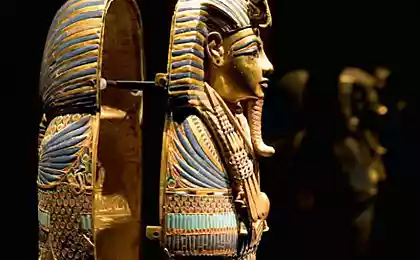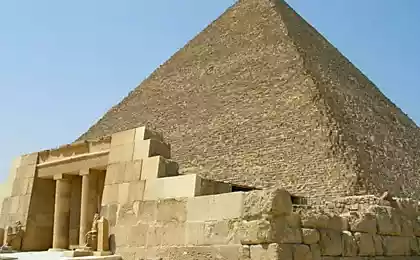1154
Secrets of the Pharaohs
It turns out, the favorite boy-king of Egypt was not so much gold. New research shows that Pharaoh Tutankhamun was actually weak teen with a cleft palate and club foot.
"He was a sick child," - says Egyptologist Emily Teeter. Based on the analysis of DNA and imaging, scientists have concluded that Tut had a genetic bone disease and malaria, which combined with a complex leg fracture, and could have caused his death at age 19 of about 3,000 years ago.
The king and his family, despite the status and wealth were as mere mortals susceptible to diseases, as well as conventional farmers - on the bodies of members of the royal family, found in the tombs were found numerous traces of malaria. Moreover, the tradition of blood marriages seriously affects the health of the pharaohs.
Recent studies have shown that Tutankhamun's father was the pharaoh Akhenaten, and his mother - the sister of his father, that is his aunt. In Egypt, it was not considered incest. Pharaohs were equated to the gods, and therefore "mixed into" other people's blood to its kind was forbidden.
37 ph via Bigpicture.ru
1. The archaeologist Howard Carter whisks away the dust from the sarcophagus with the mummy of King Tutankhamun. (Harry Burton)

2. Detailed photo of the tomb of Tutankhamun, who ruled Egypt from 1358 to 1350 years BC (AP Photo)

3. Some of the treasures found in the tomb of Tutankhamen in 1923. (AP Photo)
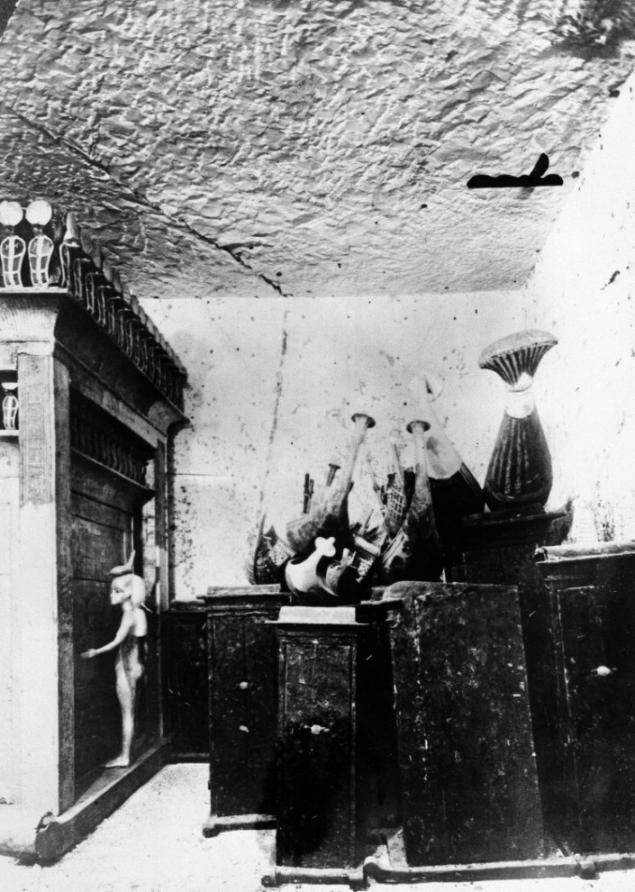
4. Archaeologists take out objects from the tomb of King Tutankhamun in the Valley of the Pharaohs in Luxor, Egypt, in 1923. (AP Photo)

5. The entrance to the tomb of Tutankhamun. (AP Photo / Ham Wright)

6. Golden tomb of Egyptian pharaoh Tutankhamen. (AP Photo)

7. One of the many discoveries during excavations in Cairo, in the tomb of Tutankhamun. (AP Photo)

8. Tomb of Tutankhamen. Photographed in the 1920s. (AP Photo)

9. Ancient artifacts from the tomb of Pharaoh endure during excavations in Cairo. (AP Photo)

10. Headgear found during excavations in Cairo in the 1920s. (AP Photo)
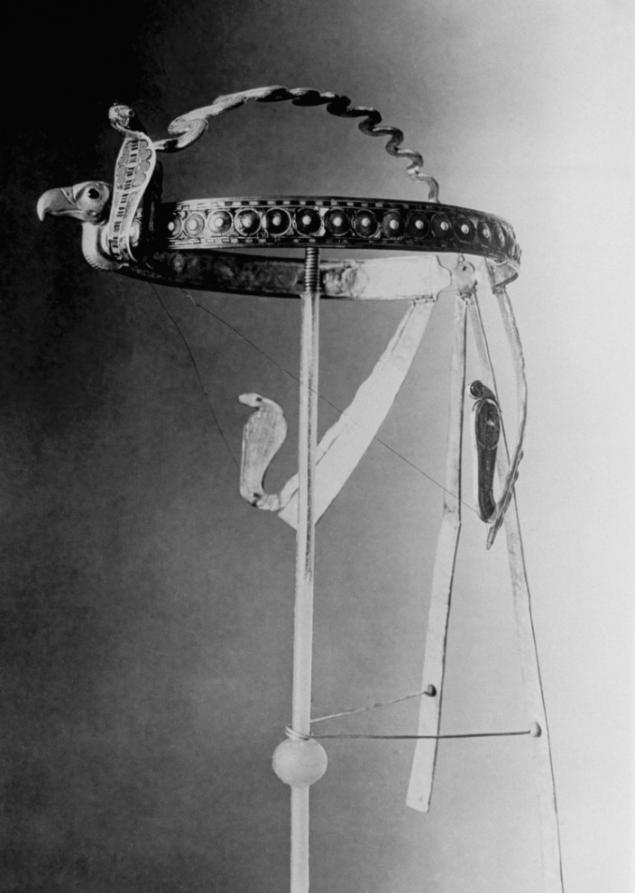
11. Archaeologists endure ancient artifacts during excavations in Cairo. (AP Photo)

12. Daggers, found during excavations at Luxor. (AP Photo)

13. The sarcophagus in the tomb of Tutankhamun. (AP Photo)

14. In this undated picture Howard Carter - the archaeologist who discovered the tomb of Tutankhamun - explores his sarcophagus. The famous Egyptian pharaoh suffered from a cleft palate and club foot, so he is likely to go, leaning on a cane. (AP Photo / File)

15. It Tutankhamun's ark, where he kept his inner vessels. Storage shining with the sun cobras and freestanding statues of the goddesses Isis, Nephthys, Neith and Cellcom. (AP Photo)
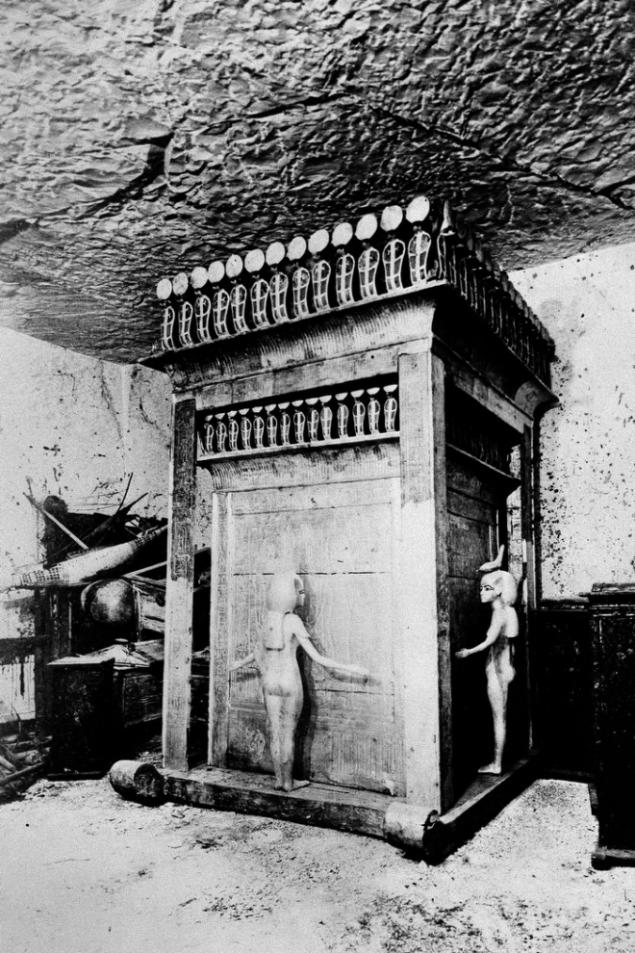
16. The statue of the young Pharaoh Tutankhamun. Photographed in 1927. (AP Photo)

17. Entrance to the tomb of Tutankhamun (center) is in front of a tourist center in the Egyptian Valley of the Pharaohs. Archaeologist John Romer worries that could flood the Nile valley. (AP Photo / Nicolas B. Tatro)
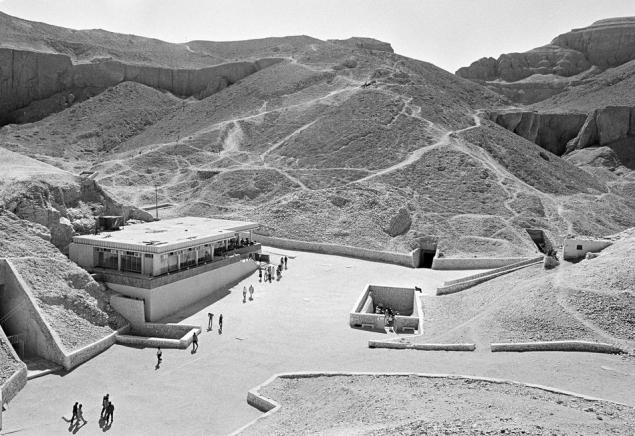
18. The mask of King Tutankhamun's golden coffin, who ruled Egypt about 1,350 BC Egipetkih treasures in the museum in Cairo. The mask of pure gold, weighs more than 10.5 kg. On the forehead - the personification of the goddesses of Northern and Southern Egypt. (AP Photo)
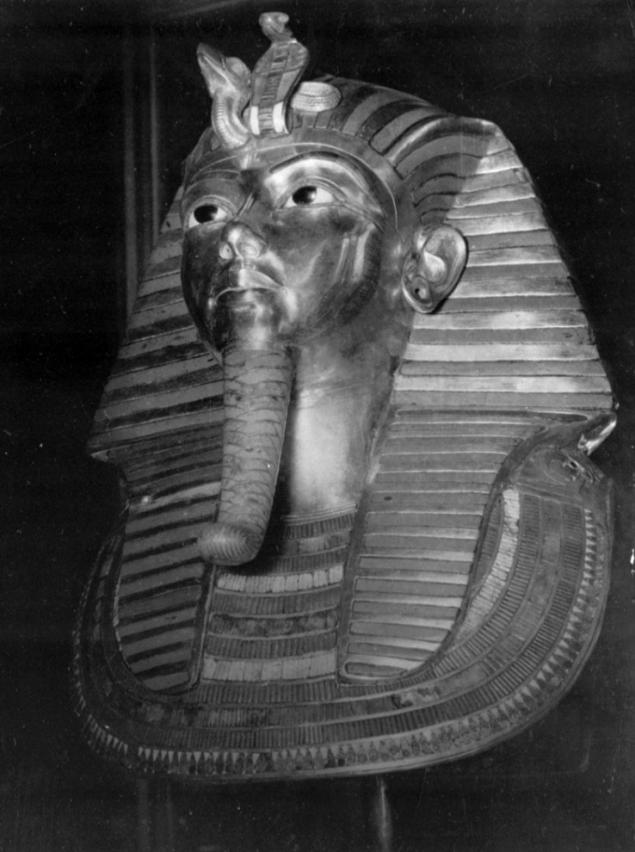
19. Employees of the National Gallery of Art in Washington removed the protective bag with a gold mask of Tutankhamun September 8, 1976. This mask, along with 55 other treasures from the tomb of Tutankhamun went to "tour" the museums of the world. Mask of Tutankhamun is decorated with carnelian, lapis lazuli, stained glass and quartz. (AP Photo / Charles Bennett)
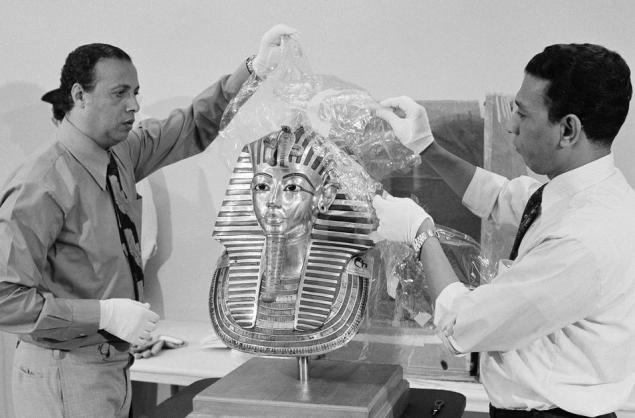
20. Barbara Hall of the University of Chicago and Yale Nilend take out the treasures of Tutankhamun in New Orleans September 6 1977. (AP Photo)

21. One of the golden sarcophagus of Tutankhamen in the museum in Cairo. This is the third and most distant coffin with a mummy made of thick gold. In the background you can see the second gold coffin. (CRIS BOURONCLE / AFP / Getty Images)

22. Wooden figure of Tutankhamun at the Franklin Institute in Philadelphia. This 3000-year-old dummy became part of an extensive collection of more than 130 objects from Tutankhamun's tomb and other tombs of the Valley of the Pharaohs, which were exhibited at the Institute from February 3 to 30 September 2007. (AP Photo / Jacqueline Larma)

23. The sarcophagus of Tutankhamen placed back into the underground tomb in the Valley of the Pharaohs November 4, 2007. Mummy 19-year-old pharaoh, whose life and death of people interested in almost a century, was placed in a special glass case with climate control, leaving uncovered only the face and feet. (AP Photo / Ben Curtis)

24. Gilded and exquisitely decorated coffin Tuji supposedly great-grandmother of Tutankhamun, presented at the Museum of Chicago in the exhibition "Tutankhamun and the Golden Age of the Pharaohs". The exhibition featured more than 130 treasures from the tomb of Pharaoh, known as the "boy king" and other royal tombs. (AP Photo / M. Spencer Green)

25. Dr. Zahi Hawass (center) follows the movement of the mummy of King Tutankhamun from his stone sarcophagus in the famous Valley of the Pharaohs in Luxor, Egypt, on 4 November 2007. (AP Photo / Ben Curtis, Pool, File)

26. The sarcophagus of Tutankhamun in his tomb after archaeologists took out the mummy of Pharaoh. Mummy protected from moisture and dirt brought by a constant stream of visitors. November 11, 2007 Egyptian authorities have restricted access to the tomb of King Tutankhamun to 400 people a day. (CRIS BOURONCLE / AFP / Getty Images)

27. Legs Pharaoh Tutankhamun in a special glass case with climate control. The present face of the famous Egyptian pharaoh was presented to the public for the first time since his bizarre death of more than 3,000 years ago. The mummy of the pharaoh moved from the sarcophagus in the tomb, where his discovery in 1922 was a sensation. (CRIS BOURONCLE / AFP / Getty Images)

28. In this image, the channel «Discovery» You can see the mummy (starting near) the mother of Tutankhamun, Tutankhamun's grandmother and the father of Tutankhamun, shown to reporters at a press conference archaeologist Zahi Hawass in Cairo museum 17 February 2010. Two years of DNA testing and tomography mummy of Tutankhamun and 15 other pharaohs helped establish the genealogical tree of the royal family, proving that Tutankhamun's father was the pharaoh Akhenaten, and his mother - his sister. (AP Photo / Discovery Channel, Shawn Baldwin)

29. The coffin with the innards of the pharaoh. Tutankhamun had four miniature coffin made of gold and semiprecious stones and colored glass. Each of them stood alone in the niche. On the line of the ancient writings from top to bottom indicate the names Imseti - one of the sons of Horus, and the goddess Isis, protects the organs inside (in this case - the liver). Decorations around the name of the Pharaoh has been reworked and originally bore the name of relatives of Tutankhamen. (AP Photo / Antikenmuseum Basel and Sammlung Ludwig, Andreas F. Voegelin)

30. The mother of Tutankhamun mummy in a glass case at a press conference in the Egyptian Museum February 17, 2010. (AP Photo / Discovery Channel, Shawn Baldwin)

31. Coffin for internal Tutankhamun exhibition at a press conference in London on 13 November 2007. (Photo by Daniel Berehulak / Getty Images)

32. One of the two mummified embryo, found in the tomb of Tutankhamen in 1922. Egyptian scientists conducted DNA tests to find out whether these embryos children young pharaoh. (AP Photo / Supreme Council of Antiquities)

33. The grandmother of Tutankhamun mummy in a glass case in a museum in Cairo February 17, 2010. (AP Photo / Discovery Channel, Shawn Baldwin)

34. The two mummies - Tutankhamun's grandmother Queen Tyui (front), and his mother-in glass cases in the museum in Cairo. (AP Photo / Nasser Nasser)
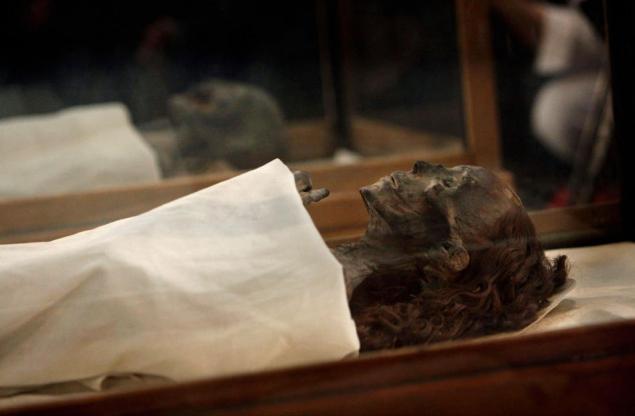
35. Tourists surrounded Tutankhamun's golden mask in the museum in Cairo February 15, 2010. (AP Photo / Amr Nabil)

36. In this photo you can see a person wrapped in a special cloth the mummy of Tutankhamun in a glass sarcophagus in the tomb of the Valley of the Pharaohs. (AP Photo / Ben Curtis, File)
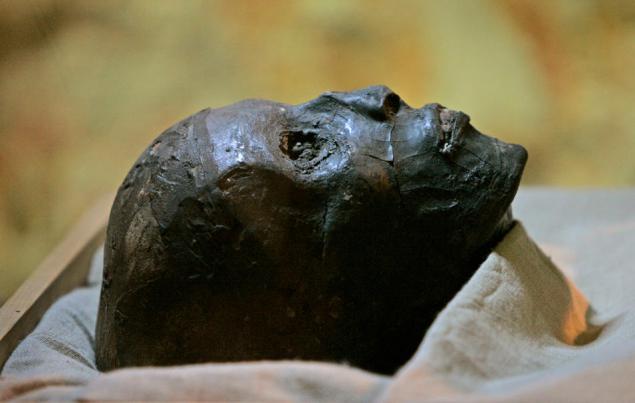
37. In this photo, a model of King Tutankhamun, created by a French team based on facial reconstructions made by computer scan of the mummy of Pharaoh. Three teams of artists and scientists from France, the United States and Egypt have created a model of the face of the young pharaoh, based on the scanned images of very high resolution. All three teams worked separately from each other. (AP Photo / Supreme Council of Antiquities and the National Geographic Society, HO)
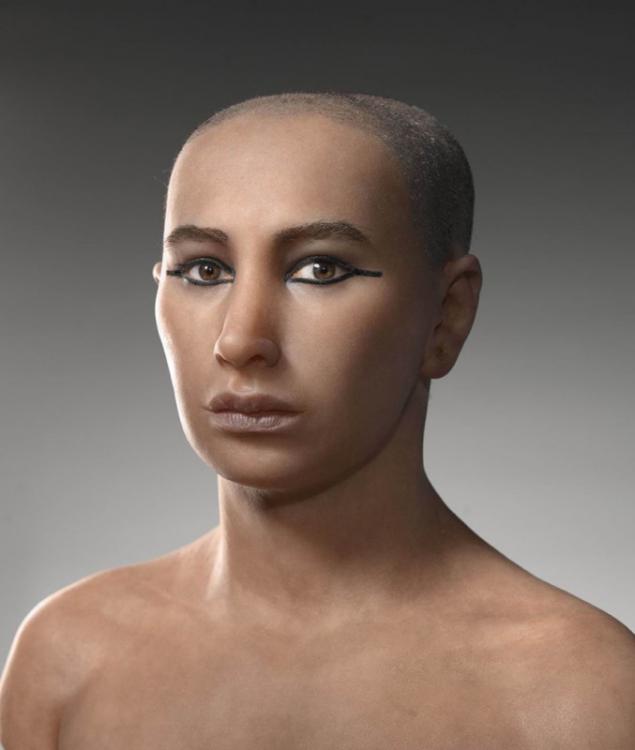
Source:
"He was a sick child," - says Egyptologist Emily Teeter. Based on the analysis of DNA and imaging, scientists have concluded that Tut had a genetic bone disease and malaria, which combined with a complex leg fracture, and could have caused his death at age 19 of about 3,000 years ago.
The king and his family, despite the status and wealth were as mere mortals susceptible to diseases, as well as conventional farmers - on the bodies of members of the royal family, found in the tombs were found numerous traces of malaria. Moreover, the tradition of blood marriages seriously affects the health of the pharaohs.
Recent studies have shown that Tutankhamun's father was the pharaoh Akhenaten, and his mother - the sister of his father, that is his aunt. In Egypt, it was not considered incest. Pharaohs were equated to the gods, and therefore "mixed into" other people's blood to its kind was forbidden.
37 ph via Bigpicture.ru
1. The archaeologist Howard Carter whisks away the dust from the sarcophagus with the mummy of King Tutankhamun. (Harry Burton)

2. Detailed photo of the tomb of Tutankhamun, who ruled Egypt from 1358 to 1350 years BC (AP Photo)

3. Some of the treasures found in the tomb of Tutankhamen in 1923. (AP Photo)

4. Archaeologists take out objects from the tomb of King Tutankhamun in the Valley of the Pharaohs in Luxor, Egypt, in 1923. (AP Photo)

5. The entrance to the tomb of Tutankhamun. (AP Photo / Ham Wright)

6. Golden tomb of Egyptian pharaoh Tutankhamen. (AP Photo)

7. One of the many discoveries during excavations in Cairo, in the tomb of Tutankhamun. (AP Photo)

8. Tomb of Tutankhamen. Photographed in the 1920s. (AP Photo)

9. Ancient artifacts from the tomb of Pharaoh endure during excavations in Cairo. (AP Photo)

10. Headgear found during excavations in Cairo in the 1920s. (AP Photo)

11. Archaeologists endure ancient artifacts during excavations in Cairo. (AP Photo)

12. Daggers, found during excavations at Luxor. (AP Photo)

13. The sarcophagus in the tomb of Tutankhamun. (AP Photo)

14. In this undated picture Howard Carter - the archaeologist who discovered the tomb of Tutankhamun - explores his sarcophagus. The famous Egyptian pharaoh suffered from a cleft palate and club foot, so he is likely to go, leaning on a cane. (AP Photo / File)

15. It Tutankhamun's ark, where he kept his inner vessels. Storage shining with the sun cobras and freestanding statues of the goddesses Isis, Nephthys, Neith and Cellcom. (AP Photo)

16. The statue of the young Pharaoh Tutankhamun. Photographed in 1927. (AP Photo)

17. Entrance to the tomb of Tutankhamun (center) is in front of a tourist center in the Egyptian Valley of the Pharaohs. Archaeologist John Romer worries that could flood the Nile valley. (AP Photo / Nicolas B. Tatro)

18. The mask of King Tutankhamun's golden coffin, who ruled Egypt about 1,350 BC Egipetkih treasures in the museum in Cairo. The mask of pure gold, weighs more than 10.5 kg. On the forehead - the personification of the goddesses of Northern and Southern Egypt. (AP Photo)

19. Employees of the National Gallery of Art in Washington removed the protective bag with a gold mask of Tutankhamun September 8, 1976. This mask, along with 55 other treasures from the tomb of Tutankhamun went to "tour" the museums of the world. Mask of Tutankhamun is decorated with carnelian, lapis lazuli, stained glass and quartz. (AP Photo / Charles Bennett)

20. Barbara Hall of the University of Chicago and Yale Nilend take out the treasures of Tutankhamun in New Orleans September 6 1977. (AP Photo)

21. One of the golden sarcophagus of Tutankhamen in the museum in Cairo. This is the third and most distant coffin with a mummy made of thick gold. In the background you can see the second gold coffin. (CRIS BOURONCLE / AFP / Getty Images)

22. Wooden figure of Tutankhamun at the Franklin Institute in Philadelphia. This 3000-year-old dummy became part of an extensive collection of more than 130 objects from Tutankhamun's tomb and other tombs of the Valley of the Pharaohs, which were exhibited at the Institute from February 3 to 30 September 2007. (AP Photo / Jacqueline Larma)

23. The sarcophagus of Tutankhamen placed back into the underground tomb in the Valley of the Pharaohs November 4, 2007. Mummy 19-year-old pharaoh, whose life and death of people interested in almost a century, was placed in a special glass case with climate control, leaving uncovered only the face and feet. (AP Photo / Ben Curtis)

24. Gilded and exquisitely decorated coffin Tuji supposedly great-grandmother of Tutankhamun, presented at the Museum of Chicago in the exhibition "Tutankhamun and the Golden Age of the Pharaohs". The exhibition featured more than 130 treasures from the tomb of Pharaoh, known as the "boy king" and other royal tombs. (AP Photo / M. Spencer Green)

25. Dr. Zahi Hawass (center) follows the movement of the mummy of King Tutankhamun from his stone sarcophagus in the famous Valley of the Pharaohs in Luxor, Egypt, on 4 November 2007. (AP Photo / Ben Curtis, Pool, File)

26. The sarcophagus of Tutankhamun in his tomb after archaeologists took out the mummy of Pharaoh. Mummy protected from moisture and dirt brought by a constant stream of visitors. November 11, 2007 Egyptian authorities have restricted access to the tomb of King Tutankhamun to 400 people a day. (CRIS BOURONCLE / AFP / Getty Images)

27. Legs Pharaoh Tutankhamun in a special glass case with climate control. The present face of the famous Egyptian pharaoh was presented to the public for the first time since his bizarre death of more than 3,000 years ago. The mummy of the pharaoh moved from the sarcophagus in the tomb, where his discovery in 1922 was a sensation. (CRIS BOURONCLE / AFP / Getty Images)

28. In this image, the channel «Discovery» You can see the mummy (starting near) the mother of Tutankhamun, Tutankhamun's grandmother and the father of Tutankhamun, shown to reporters at a press conference archaeologist Zahi Hawass in Cairo museum 17 February 2010. Two years of DNA testing and tomography mummy of Tutankhamun and 15 other pharaohs helped establish the genealogical tree of the royal family, proving that Tutankhamun's father was the pharaoh Akhenaten, and his mother - his sister. (AP Photo / Discovery Channel, Shawn Baldwin)

29. The coffin with the innards of the pharaoh. Tutankhamun had four miniature coffin made of gold and semiprecious stones and colored glass. Each of them stood alone in the niche. On the line of the ancient writings from top to bottom indicate the names Imseti - one of the sons of Horus, and the goddess Isis, protects the organs inside (in this case - the liver). Decorations around the name of the Pharaoh has been reworked and originally bore the name of relatives of Tutankhamen. (AP Photo / Antikenmuseum Basel and Sammlung Ludwig, Andreas F. Voegelin)

30. The mother of Tutankhamun mummy in a glass case at a press conference in the Egyptian Museum February 17, 2010. (AP Photo / Discovery Channel, Shawn Baldwin)

31. Coffin for internal Tutankhamun exhibition at a press conference in London on 13 November 2007. (Photo by Daniel Berehulak / Getty Images)

32. One of the two mummified embryo, found in the tomb of Tutankhamen in 1922. Egyptian scientists conducted DNA tests to find out whether these embryos children young pharaoh. (AP Photo / Supreme Council of Antiquities)

33. The grandmother of Tutankhamun mummy in a glass case in a museum in Cairo February 17, 2010. (AP Photo / Discovery Channel, Shawn Baldwin)

34. The two mummies - Tutankhamun's grandmother Queen Tyui (front), and his mother-in glass cases in the museum in Cairo. (AP Photo / Nasser Nasser)

35. Tourists surrounded Tutankhamun's golden mask in the museum in Cairo February 15, 2010. (AP Photo / Amr Nabil)

36. In this photo you can see a person wrapped in a special cloth the mummy of Tutankhamun in a glass sarcophagus in the tomb of the Valley of the Pharaohs. (AP Photo / Ben Curtis, File)

37. In this photo, a model of King Tutankhamun, created by a French team based on facial reconstructions made by computer scan of the mummy of Pharaoh. Three teams of artists and scientists from France, the United States and Egypt have created a model of the face of the young pharaoh, based on the scanned images of very high resolution. All three teams worked separately from each other. (AP Photo / Supreme Council of Antiquities and the National Geographic Society, HO)

Source:



